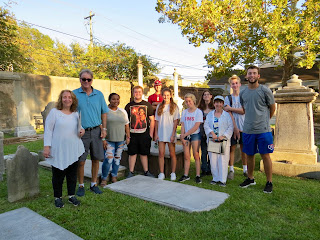 |
| For late September it was unseasonably hot this day |
For my College of Charleston “Beyond the Grave” students, a Saturday night cemetery tour would not be high on their weekend fun list. But I tried to make it more palatable by not meeting in our classroom. Instead we met in front of the Addlestone Library and then walked several blocks to the cemetery.
All but a few of my 20 students participated on Sept. 28, though several left before this group photo was taken by my wife Alesia.
 |
| Serrins (left) and Rosenberg regularly give tours here |
KKBE historians Randi Serrins and Anita Rosenberg (pictured left speaking to my students) are guardians of the cemetery, which is only open by appointment.
We have visited several Christian graveyards in Charleston. Each one is right by the church. But the Jewish custom is different. A graveyard is not allowed to be near the synagogue.
“The priestly caste would not go where bodies were buried,” Rosenberg said.
Wow, that's interesting, I thought.
1762-2019. Wow there also. This cemetery has been here for 257 years!
Time has taken its toll on some of the gravesites and parts of the high wall that surrounds the one acre cemetery, which is the eternal home to 800 Charleston Jews. Rosenberg and Serrins are working to reverse the damage.

They have brought in the expertise of Monica Hendricks (pictured above right speaking with student
Hannah Lees). Hendricks is a graduate student in the College of Charleston’s Historic Preservation program.
Hendricks, in recent months, has methodically and skillfully repaired and rebuilt several broken markers. This is giving new life to a place of death with a proud heritage and history.
 |
| Stones show respect and that someone has not been forgotten |
What’s with the rocks? I’ve noticed this here and at other Hebrew cemeteries. You often see small pebbles placed on grave markers like in the above photo.
Serrins explained this tradition. “I’m here to honor you,” she said of what it means today.
In ancient times in the Middle East when Jews were buried in the desert, “they would be covered with rocks so animals couldn’t dig up and eat the body,” Serrins said.
Serrins and Rosenberg share many interesting stories about the lives and deaths of Charleston's early Jewish population who seemed to thrive here due to the religious and other freedoms granted to settlers as a way to market the vast Carolina Colony. Jews could also vote and own property. Not every British colony had such rights and freedoms.
 |
| Thank you students for a fine Saturday adventure! |
I highly recommend tours at the Coming Street Cemetery and the KKBE synagogue, which has its own museum and gift shop. For more information, call 843.723.1090 or email Anita Rosenberg at anitamrose@comcast.net or Randi Serrins at randiserrins@gmail.com.
I have previously blogged about Coming Street Cemetery and KKBE. See the embedded links to read those.






No comments:
Post a Comment